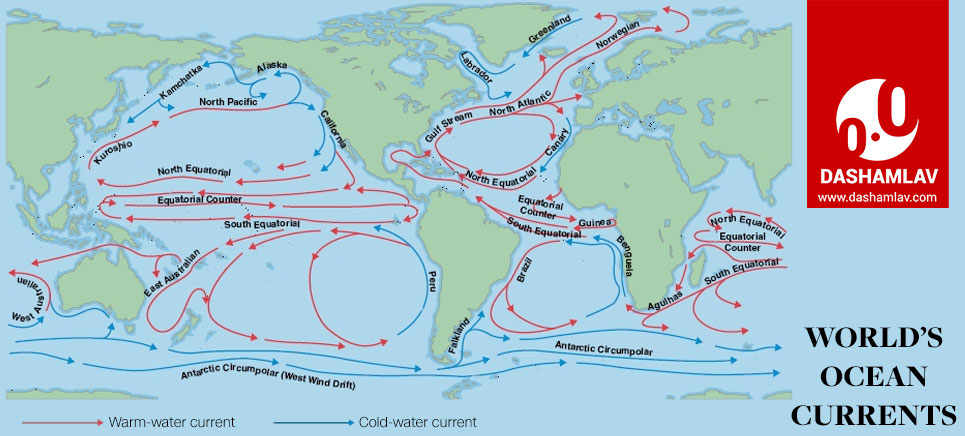We have classified all the list of major ocean currents of the world on the basis of temperature: cold ocean currents and warm ocean currents.
We have also discussed some of the important facts related to ocean currents. Find below the extensive lists of cold and warm ocean currents of the world respectively.
List of Cold Ocean Currents
| Cold Ocean Current | Region | Important or Additional Facts |
|---|---|---|
| Humboldt or Peruvian Current | South Pacific Ocean |
|
| Kurile or Oya shio Current | North Pacific Ocean |
|
| California Current | Pacific Ocean |
|
| Antarctic Circumpolar Current | Southern Ocean |
|
| Labrador Current | North Atlantic Ocean |
|
| Canary Current | North Atlantic Ocean |
|
| Eastern Greenland Current | Arctic Ocean & North Atlantic Ocean |
|
| Benguela Current | South Atlantic Ocean |
|
| Falkland Current | South Atlantic Ocean |
|
| Northeast Monsoon Current | North Indian Ocean |
|
| Somali Current | West Indian Ocean |
|
| Western Australian Current | Southern Ocean & South Indian Ocean |
|
| South Indian Ocean Current | South Indian Ocean |
|

List of Warm Ocean Currents
| Warm Ocean Current | Region | Important or Additional Facts |
|---|---|---|
| North Equatorial Current | Pacific Ocean & Atlantic Ocean |
|
| Kuroshio Current | Pacific Ocean |
|
| North Pacific Current | Pacific Ocean |
|
| Alaskan Current | North Pacific Ocean |
|
| Equatorial Counter Current | Atlantic Ocean, Pacific Ocean, and the Indian Ocean |
|
| El Nino Current | Central & East-Central Equatorial Pacific |
|
| Tsushima Current | Sea of Japan |
|
| South Equatorial Current | Atlantic Ocean, Pacific Ocean, and the Indian Ocean |
|
| East Australian Current | South-Western Pacific Ocean |
|
| Florida Current | South Atlantic Ocean & Caribbean Sea |
|
| Gulf Stream | North Atlantic Ocean |
|
| Norwegian Current | North Sea (Atlantic Ocean) & Barents Sea (Arctic Ocean) |
|
| Irminger Current | North Atlantic Ocean |
|
| Antilles Current | North Atlantic Ocean |
|
| Brazilian Current | South Atlantic Ocean |
|
| Mozambique Current | Indian Ocean |
|
| Agulhas Current | South-West Indian Ocean |
|
| Southwest Monsoon Current | Indian Ocean |
|
Citation
Use the citation below to add this article to your bibliography
Use the citation below to add this article to your bibliography
Styles:
"List of Major Ocean Currents in the World." Dashamlav.com. Web. 27 July 2024. <https://dashamlav.com/ocean-currents-list/>
Dashamlav.com, "List of Major Ocean Currents in the World." Accessed 27 July 2024. https://dashamlav.com/ocean-currents-list/
"List of Major Ocean Currents in the World." (n.d.). Dashamlav.com. Retrieved 27 July 2024 from https://dashamlav.com/ocean-currents-list/
